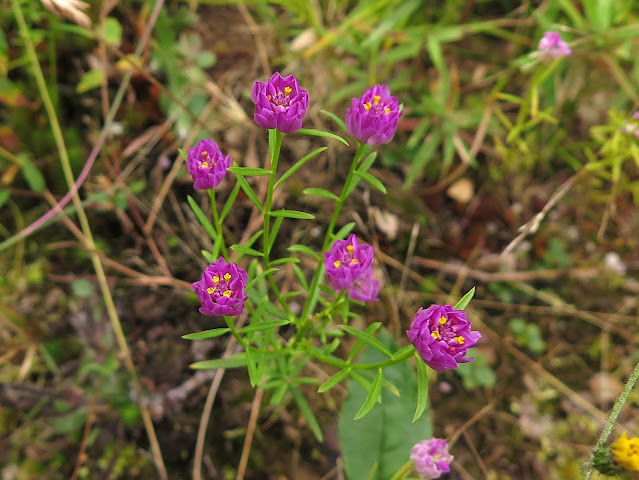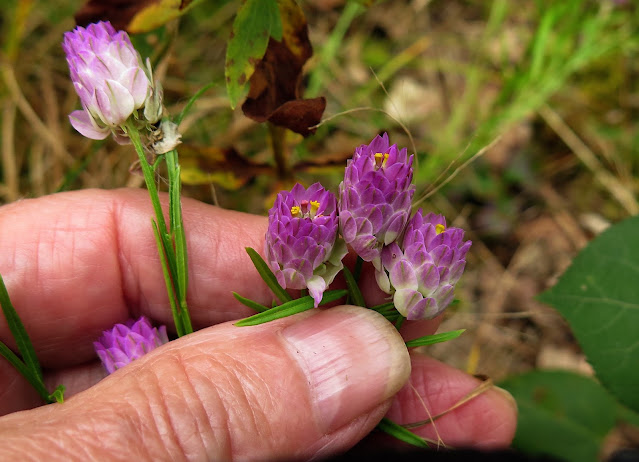An east/west powerline intersects a north/south lane in the middle of the densely wooded Daniels Road State Forest Preserve, just north of Saratoga. Two straight lines, easy walking, no way to get lost in the woods. A friend had told me about an abundant patch of Purple Milkwort (Polygala sanguinea) alongside this powerline, the flowers massed just steps from the preserve's parking area, he said. So on Friday, off I went to find them, driving north about a half-mile into the woods to the parking area, then headed east on the powerline. I could easily see this intersection pictured below from where I parked my car.
Here's what Purple Milkwort looks like. It's small (similar in size to a clover flower), but such a bright pink I was sure I couldn't miss it.
But miss it, I did! I walked and walked and walked along the powerline, heading east, searching the grass along either side, but found no dots of bright purple. Hmm, I thought to myself, I must be walking the wrong side of the powerline. (I'd forgotten my friend's directions.) Better go back to the lane I drove in on and continue on the powerline heading west. But just as I thought this, I spied some beautiful Yellow Ladies' Tresses (Spiranthes ochroleuca) off trail near the woods. Oh boy, I rarely see these! Better get some good photos. So I knelt down, circling around the plants to get shots of it from all angles. That was my first mistake.

But I did not realize my mistake until some time later. When I rose from my knees I started walking what I assumed was back toward the lane, not realizing that I had got myself turned around and was actually walking away from the lane. I walked and walked and walked, feeling a bit amazed that I had come so far. But then I started noticing trailside features that I knew I'd not passed before. WHAT?!!! Oh dear, I must be going the wrong direction! So I turned around and walked and walked and walked and walked and never found the lane. Stunned and disoriented, I questioned my sense of direction once more, and after repeating my exertions again and never finding the lane in either direction, I totally panicked. I had enough sense to know that I had left the lane by traveling east, so all I had to do was keep heading west and that lane would eventually appear. But clouds had covered the sun so there were no afternoon shadows to indicate east from west, and I had no compass. (Lesson learned: never leave home without one!) Frightened and exhausted, but lucky there was cell service here and I had a charged-up cellphone, I stationed myself by a numbered power pole and dialed 911. Long story short, a dear young sheriff's deputy found me not 15 minutes after my call for help and escorted me out through the woods to where he had parked his patrol car nearly a mile away. He then drove me back to where my car was parked. Oh boy, did I feel stupid! I could not thank my escort enough, but he told me he'd much rather help a lady find her way out of the woods than stop somebody for speeding. How dear and kind of him! He made me feel very happy that my taxes go to provide such help for the lost.
But I still felt much chagrin that I had made such a stupid mistake, and even worse, that I'd never found the flowers! So back to the scene of the drama I returned the next day, full of strategies about how to determine directions, as well as clear instructions from my friend about exactly where to find the Purple Milkworts, just steps from the parking area. This time I headed WEST on the powerline. And I kept turning around to keep the lane well in view. I also gazed beyond the lane to where I could see mountains rising far to the east. I could see no mountains, even from a rise in the path, by gazing to the west. So now I had a sure reference. Those mountains weren't going anywhere. Now I could relax and enjoy the walk.
Just as my friend had told me, the milkworts were only a few yards away from the intersection of powerline and roadway. And oh my gosh, there were HUNDREDS! I could hardly walk among them without fear of trampling them.
I have seen this lovely flower before, but never with blooms of such an intense color.
Secure that I could still see the lane from a kneeling position, I once again knelt down to closely admire and photograph the blooms.
Just look at the teeny tiny multicolored flowers held within the surrounding purple bracts! Like a tiny bouquet wrapped in purple tissue paper. They remind me of those Italian porcelains called Capodimonte, which render tiny delicate flowers, often contained in little porcelain baskets.
These flowers must keep blooming for quite a long time, continuing to add new tiers of delicate bracts as the blossoms age. Evidently, these Purple Milkworts have been blooming for quite a while!
Mission accomplished and shame assuaged, I continued walking west on the powerline clearcut, delighting in many of the other wildflowers along the way. The wayside meadows were a sea of goldenrods, probably of several species, but I was content to enjoy their beauty without having to know their exact names. This bumblebee didn't care whose nectar it was imbibing.
I did recognize these small yellow flowers as belonging to Rough Hawkweed (Hieracium scabrum), one of our native hawkweeds and one with roughish leaves that climb the hairy stems.
At first glance, I surmised that these starry white flowers were those of Frostweed Aster (Symphyotricum pilosum), because of their relatively large size and the plant's open habit of growth. But wait: these stems were smooth, not hairy, as the specific name "pilosum" would indicate. So this aster is likely the hairless variety of S. pilosum called Pringle's Aster: Symphyotrichum pilosum var. pringlei.
This thickly florabundant pale-purple aster could be the Wavy Aster (Symphyotrichum undulatum), to judge from how the pedicels of its lower leaves widened before they met the stems. But I am never sure of species when it comes to asters. We have so many species, and they do hybridize with each other at times.
This bumblebee was feeding on what I at first assumed was Spotted Knapweed. But then I noticed the slender lance-like leaves along the stem, not the deeply-cut leaves of that very invasive non-native weed. I then decided this must be Brown Knapweed (Centaurea jacea) instead. The Brown Knapweed (a species introduced from Europe) is possibly just as invasive in the U.S. as the Spotted Knapweed, but I do find it growing wild much less often and much less abundantly in the places I usually visit.
The brown fringed bracts on the Brown Knapweed's involucre are one of the keys to its identification, along with those narrow uncut leaves.
When I saw the bright-yellow blooms of Nodding Bur-marigold (Bidens cernua), I guessed that it had found its way to a bit of a wetland beneath these powerlines. Sure enough, as I approached, I stepped down into a swale that was thick with the barbed stems of Arrowleaf Tearthumb grabbing at my pantlegs, and my feet could feel soft damp soil beneath my shoes.
Slender Agalinis (Agalinis tenuifolia) is another denizen of damp places, and sure enough, I found in this little swale a few of its pretty purple flowers still blooming among the frothy remains of its many plants now gone to seed.
And sure enough, here also bloomed the well-named wetland denizen called Swamp Aster (Symphyotricum puniceum). Another name for this aster is Purple-stemmed Aster, although it doesn't always have a purple stem. But it does always grow where the soil is damp. And it always has a hairy stem. Since "puniceum" means "pink" in Latin, I'm still pondering why it earned that name, since its flowers look more blue than pink. This is our earliest showy aster to bloom, and it keeps on blooming very late in the season.
There were also rocky outcroppings along the powerline, perfect habitat for many interesting mosses and lichens and clubmosses. I recognized the spiky Bristly Haircap Moss (Polytricum piliferum) poking up through these wavy-leaved mounds of a gray-green lichen, but I will have to ask one of my bryologist friends to help me put a name to the lichen. I found it beautiful, but it was quite unfamiliar to me.
I did recognize these pale fruiticose lichens as one of the Reindeer Lichens (Cladonia species), but my attention was taken up almost entirely by the green spiky tufts of Rock Spikemoss (Selaginella rupestris), which is not really a moss, being more closely related to ferns. Although it is quite widespread in its range, it is not a very common find.
The white tufts on the ends of these Running Clubmoss branches have suggested other vernacular names for Lycopodium clavatum: Wolf's Claw and Stag's Horn among them. The yellow candelabras are the clubmoss's spore stalks.
Here was another clubmoss, a species called Blue Clubmoss (Diphasiastrum tristachyum), although it's only a little bit bluer than other Diphasiastrum species. What distinguishes this one is that its stolons run beneath the surface of the ground instead of along the top. And yes, a bluish cast to its green leaves.
The grassy meadows under the powerline had their own way of being beautiful. I particularly love our native Little Bluestem Grass (Schizachyrium scoparium) in the fall, when its fine stalks (more red than blue!) hold fluffy tufts of the seedheads all along the stems.
There was one section where the grass was distinctly yellow, and its seedheads looked like fluffy yellow-orange caterpillars. Can any one of my readers put a name to this pretty grass? I confess that grasses are one of my areas of ignorance. But that doesn't mean my appreciation for their beauty is lacking.
I did see some small yellow butterflies along the way, very busy among the asters, but none would hold still for the picture-taking. But this handsome fellow (gal?) did hold still. A beautiful insect indeed! Note that it was perched on the hairless stems of a Pringle's Aster!
On the other hand, this little critter did not hold still at all! It was all I could do to hold onto this wee little Dekay's Brown Snake as it wriggled and swayed in my hand -- let alone get its cute little face in focus! I've been told that this snake never gets much bigger than this, so I'm glad to know my grip wasn't terrifying a helpless little baby. I promptly let it go.



















































